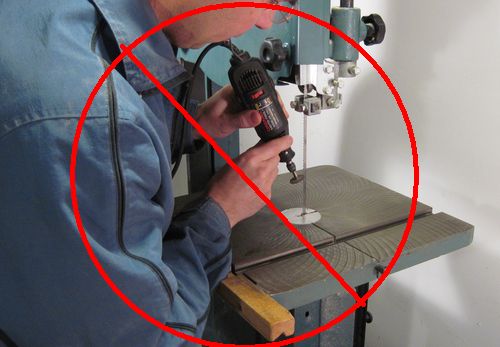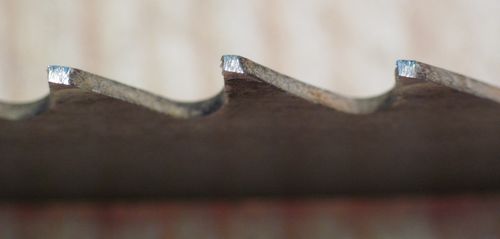Are you wondering if you can sharpen a bandsaw blade? Well, you’ve come to the right place! Sharpening a bandsaw blade is a topic that many woodworking enthusiasts are curious about.
If you’ve ever used a bandsaw, you know how crucial a sharp blade is in getting clean, precise cuts. Over time, however, blades can become dull and lose their cutting effectiveness. So, can you give your bandsaw blade a new lease on life by sharpening it?
In this article, we’ll dive into the world of bandsaw blades and explore whether or not it’s possible to sharpen them. So, grab your safety goggles, and let’s find out together!
Sharpening a bandsaw blade is a straightforward process that can extend its lifespan. Follow these steps to sharpen your bandsaw blade:
- Clean the blade to remove any debris.
- Secure the blade in a vise or clamp.
- Use a file to file each tooth of the blade at a consistent angle.
- File the tooth until the edge is sharp.
- Repeat the process for each tooth.
Regularly sharpening your bandsaw blade will ensure cleaner cuts and improved performance.

Can You Sharpen a Bandsaw Blade?: Unlocking the Secrets to Blade Maintenance
Having a sharp bandsaw blade is crucial for achieving clean and precise cuts in woodworking projects. But what happens when your blade starts to dull? Is it possible to sharpen a bandsaw blade and bring it back to its former glory? In this article, we will delve into the world of bandsaw blade sharpening and explore the techniques, tools, and tips you need to know to maintain a sharp blade and maximize the lifespan of your bandsaw.
The Importance of Blade Maintenance
A dull bandsaw blade not only compromises the quality of your cuts but also puts unnecessary strain on your bandsaw motor. This can lead to overheating, premature wearing of the tires, and may even result in damage to the blade itself. Regular blade maintenance, including sharpening, is essential for ensuring smooth and efficient cutting operations. By investing some time and effort into blade maintenance, you can save money on blade replacements and achieve superior woodworking results.
To sharpen a bandsaw blade, you have two main options: do it yourself or seek professional help. Most bandsaw blades can be sharpened at home using the appropriate tools and techniques. However, if you lack the necessary skills or don’t have access to the right equipment, it’s best to rely on the expertise of a professional sharpening service. Now let’s explore both options in more detail.
Sharpening a Bandsaw Blade at Home
Sharpening a bandsaw blade at home can be a cost-effective and convenient solution if you have the necessary tools and skills. However, it requires attention to detail and some practice to achieve optimal results. Here’s a step-by-step guide to help you get started:
1. Inspect the Blade: Before sharpening, carefully inspect the blade for any teeth that are chipped, broken, or missing. It’s crucial to replace damaged teeth before proceeding with the sharpening process.
2. Preparation: Set up a suitable work area with good lighting. Ensure you have a sturdy workbench, safety goggles, a bandsaw blade sharpening jig, a flat file, a grinding wheel, and a wire brush.
3. Blade Cleaning: Remove any dirt, debris, or resin buildup from the blade using a wire brush. This will prevent the sharpening process from being hindered by any obstructions.
4. Blade Clamping: Attach the blade to the sharpening jig following the manufacturer’s instructions. Make sure the blade is securely clamped to prevent movement during the sharpening process.
5. Sharpening: Use a flat file or a grinding wheel to shape the teeth of the blade. Follow the angle and shape of the existing teeth to maintain consistency. Take your time and apply even pressure to achieve uniform results.
6. Test and Adjust: After sharpening, test the blade on a scrap piece of wood to ensure it cuts smoothly and cleanly. If necessary, make any final adjustments to the tooth shape or angle.
Professional Blade Sharpening Services: The Benefits
While sharpening a bandsaw blade at home can be a DIY project, there are several benefits to entrusting the task to a professional sharpening service:
1. Expertise and Precision: Professional sharpening services have the knowledge, experience, and specialized equipment to sharpen blades accurately and consistently. This guarantees optimal cutting performance and extends the life of your blade.
2. Save Time and Effort: Sharpening a bandsaw blade can be a time-consuming process, especially for beginners. By using a professional service, you can focus on your woodworking projects, knowing that your blade will be expertly sharpened and ready for use when you need it.
3. Quality Assurance: Professional sharpening services adhere to strict quality standards. They perform thorough inspections to identify any potential issues, such as damaged teeth or blade distortion, and take appropriate measures to ensure your blade is in top condition.
In Conclusion
Maintaining a sharp bandsaw blade is essential for achieving accurate and clean cuts in your woodworking projects. Whether you choose to sharpen your blade at home or seek professional assistance, regular maintenance is key to prolonging the lifespan of your blade and optimizing cutting performance. By following the proper techniques and investing in the necessary tools or professional services, you can enjoy the benefits of a sharp bandsaw blade for years to come. So, keep those cuts precise and your woodworking projects on point with a properly sharpened bandsaw blade!
Key Takeaways: Can You Sharpen a Bandsaw Blade?
- Yes, you can sharpen a bandsaw blade to extend its lifespan.
- Using a specialized bandsaw blade sharpener is recommended.
- Proper sharpening technique is crucial to maintain blade performance.
- Regular maintenance and cleaning of the bandsaw blade are important.
- Sharpening a bandsaw blade yourself can save money, but professional sharpening services are available too.
Frequently Asked Questions
Here are some commonly asked questions about sharpening a bandsaw blade.
1. How often should I sharpen my bandsaw blade?
It is recommended to sharpen your bandsaw blade every 10-15 hours of use, or whenever you start to notice a decrease in cutting performance. Dull blades can lead to rough cuts and can put unnecessary strain on your saw.
Regular sharpening not only ensures precise cuts but also extends the lifespan of your blade. Keep in mind that high-speed steel blades might require less frequent sharpening than carbon steel blades.
2. Can I sharpen a bandsaw blade myself?
Yes, you can sharpen a bandsaw blade yourself using a few tools and techniques. One popular method is using a file or a belt sander. Start by cleaning the blade, then carefully file or grind the teeth to restore their sharpness.
However, it’s important to note that sharpening a bandsaw blade is a skill that requires practice and precision. If you’re new to blade sharpening or unsure of your abilities, it might be best to seek professional assistance to ensure optimal results.
3. What are the signs of a dull bandsaw blade?
Several signs indicate that your bandsaw blade might be dull. If you notice an increase in feed pressure, burning or scorch marks on the wood, or if the saw starts to wander off course during a cut, it’s likely time for sharpening.
Another telltale sign is a decrease in cutting speed or the saw struggling to make smooth, clean cuts. As soon as you see any of these signs, it’s advisable to sharpen your bandsaw blade to maintain efficient and precise cutting performance.
4. How much does it cost to have a bandsaw blade professionally sharpened?
The cost of professionally sharpening a bandsaw blade can vary depending on several factors. Blade length, tooth configuration, and the service provider you choose can all influence the cost. However, on average, you can expect to pay between $10 and $30 per blade for professional sharpening.
While it may incur an additional cost, the advantage of professional sharpening lies in the expertise and specialized equipment available. This ensures that your blade is sharpened correctly, prolonging its lifespan and ensuring optimal cutting performance.
5. Can a dull bandsaw blade be dangerous to use?
Using a dull bandsaw blade can indeed be dangerous. When a blade is dull, it requires increased feed pressure to cut through materials. This can cause sudden slips or kickbacks, which can result in injuries or damage to the workpiece.
A dull blade can also cause excessive heat, leading to burning or scorch marks on the material. Plus, the quality of the cuts will be compromised, resulting in rough edges and an overall poor finish. Therefore, it’s crucial to keep your bandsaw blade sharp to ensure safe and efficient operation.

Summary
Sharpening a bandsaw blade is not recommended because the teeth are hardened and cannot be filed. Instead, it is better to replace the blade when it gets dull to ensure optimal performance. However, if you really want to try sharpening, you can use a diamond-coated file or a specialized sharpening tool designed for bandsaw blades. Remember to follow the manufacturer’s instructions and take safety precautions.
In conclusion, it is best to replace a dull bandsaw blade rather than trying to sharpen it. If you do decide to sharpen, make sure to use the right tools and be cautious.
